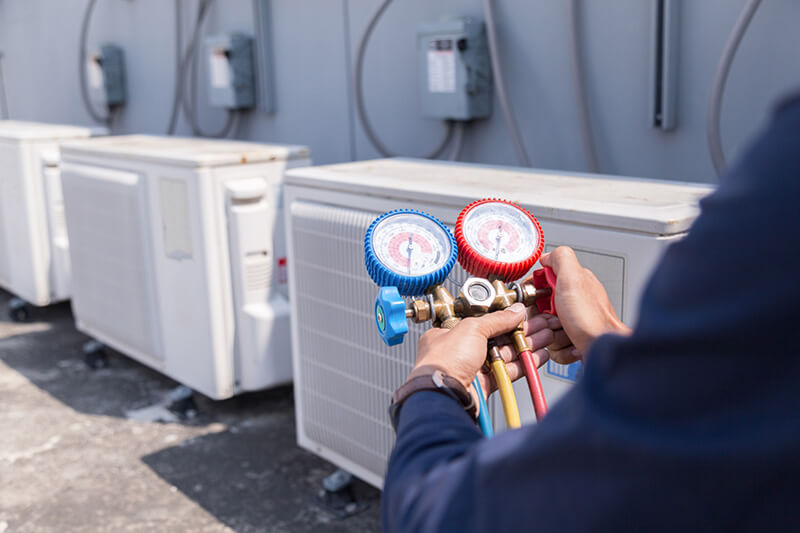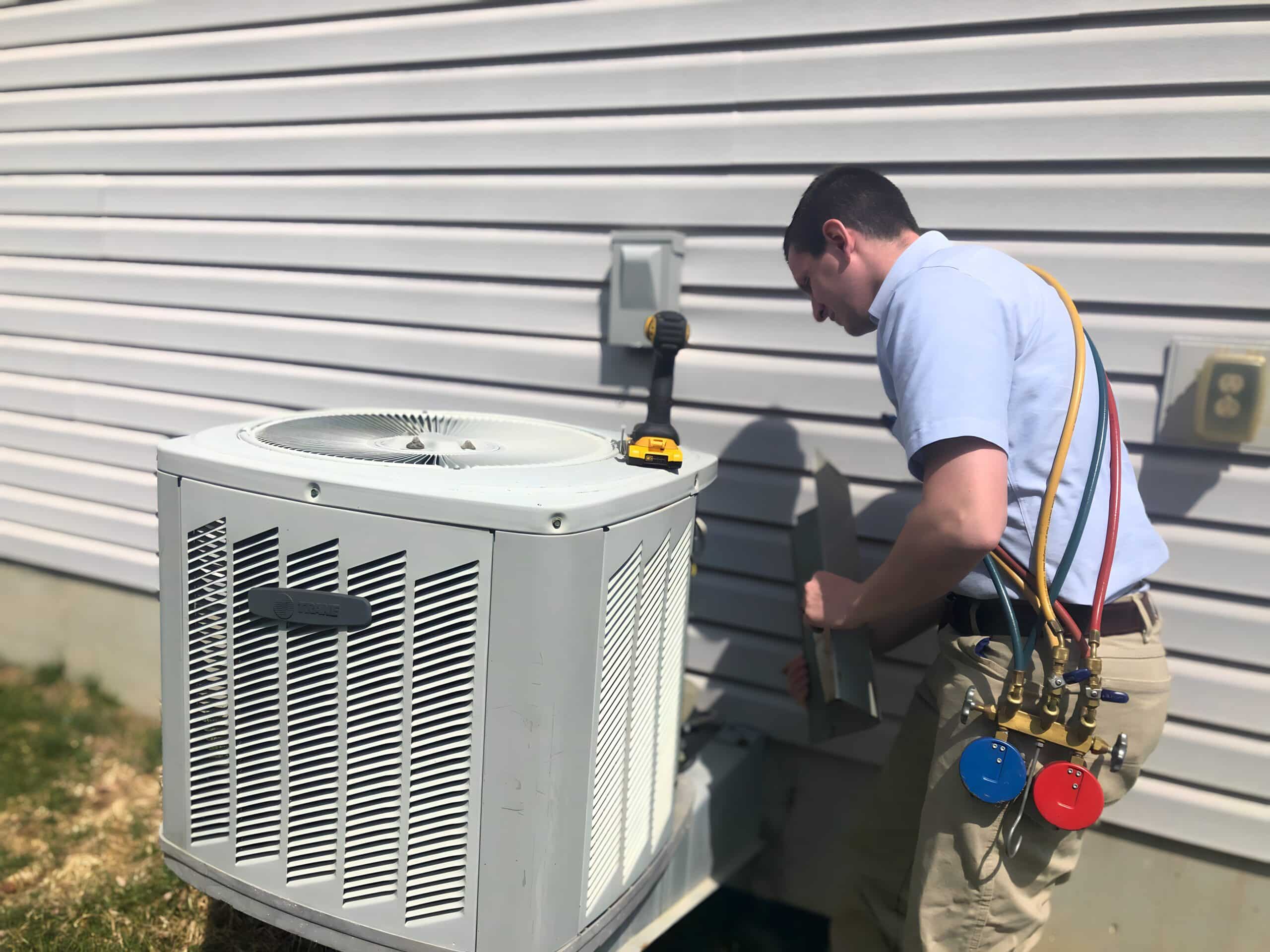How a Warmth Pump and Heater Collaborate to Maximize Your Home's Heating Efficiency
Recognizing exactly how a heat pump and heater work together is crucial for house owners seeking reliable heating solutions. Each system has its staminas, providing a balanced approach to home convenience. The warmth pump masters moderate temperatures, while the heater supplies quick warmth during severe cold. This synergy not just reduces power costs however also improves the life-span of both devices. What aspects influence this cooperation, and how can property owners optimize their benefits?
Comprehending Heat Pumps: Exactly How They Function
Although many individuals might be not familiar with their internal operations, heatpump play an essential function in modern-day heating unit. These gadgets run by moving heat from one place to one more, making use of the concepts of thermodynamics. In colder months, a heat pump essences warm from the outdoors air, ground, or water, and transfers it inside to warm the living area. On the other hand, throughout warmer months, it can turn around the procedure, working as an ac unit by removing heat from inside to the outside.Heat pumps contain an evaporator, condenser, development, and compressor shutoff. The cooling agent within the system soaks up warmth as it vaporizes at reduced temperature levels and pressures. The compressor then boosts the pressure and temperature of the refrigerant, allowing it to launch warmth as it condenses. This reliable procedure can substantially reduce power intake contrasted to standard home heating techniques, making warm pumps a sustainable choice for climate control in homes.
The Role of Furnaces in Home Home Heating
Heaters play a crucial duty in home heating by providing a reputable source of warmth throughout the cooler months. They operate by generating warmth via burning or electric resistance, dispersing it throughout the home using air ducts or radiant systems. The efficiency of a heater is commonly determined by its Annual Gas Use Effectiveness (AFUE) rating, which shows exactly how efficiently the device transforms fuel right into heat.Furnaces can use various power sources, consisting of natural gas, lp, electricity, or oil, enabling homeowners to pick the most ideal option for their demands. Unlike heatpump, which might struggle in severe cold, heating systems keep constant efficiency, ensuring that interior temperature levels remain comfy despite outside problems. Additionally, contemporary heaters typically come outfitted with advanced innovation, such as variable-speed blowers and smart thermostats, boosting their performance and responsiveness. This flexibility makes heaters an essential element in comprehensive home heating strategies.

Benefits of Utilizing Both Solutions Together
Incorporating the toughness of both heating systems and heat pumps can lead to an extra reliable and effective home heating service. Utilizing both systems permits house owners to make the most of the heatpump's power efficiency throughout milder temperatures while counting on the heater for more severe cold conditions. This dual technique can greatly decrease power expenses, as heat pumps eat less electricity than typical heating approaches when temperatures are moderate.Additionally, making use of both systems together can boost comfort degrees in the home. Heat pumps can give consistent, also heating, while furnaces can swiftly raise ambient temperature levels when needed. Moreover, the integration of both systems can expand the lifespan of devices by reducing deterioration on each device, as they share the workload. Ultimately, house owners can enjoy a balanced, cost-efficient heating service that changes seamlessly to varying climate condition, ensuring a warm and inviting home throughout the winter season.
Just How Warmth Pumps and Furnaces Complement Each Other
When house owners incorporate warmth pumps and furnaces, they create a complementary heating unit that makes best use of efficiency and convenience. Heatpump operate by transferring heat from the outside air or ground, making them highly efficient in moderate climates. They excel throughout milder temperature levels, providing cost-effective heating. Conversely, furnaces create warmth via burning or electrical resistance, providing strong, immediate heat throughout severe chilly conditions.The combination of these two systems permits for vibrant modifications based on temperature fluctuations. Throughout warmer months or milder winter months days, the warmth pump can take the lead, preserving power and lowering prices. As temperature levels drop, the furnace can seamlessly involve, making sure constant heat throughout the home. This harmony not only optimizes power use but additionally improves the life expectancy of both systems, as each unit runs within its optimal performance array. With each other, they create a well balanced atmosphere that adapts to differing climate needs.
Enhancing Efficiency: Tips for Homeowners
Homeowners can enhance their home heating effectiveness through numerous useful techniques. Establishing a routine maintenance routine, incorporating clever thermostat technology, and applying effective insulation and securing options are key actions. These procedures not just enhance convenience however also reduce power costs.
Routine Upkeep Schedule
To assure maximum home heating effectiveness, establishing a routine upkeep timetable is necessary for any home. Home owners must prioritize regular examinations of both heatpump and heating systems to establish peak performance. This consists of transforming air filters each to three months, as blocked filters can considerably lower effectiveness. Additionally, scheduling professional maintenance at the very least yearly enables specialists to identify and deal with potential problems before they intensify. Home owners need to also clean the heatpump's outdoor system to stop particles accumulation that can hinder airflow. By adhering to a regular upkeep timetable, homeowners not only boost their home heating systems' performance but likewise extend their lifespan, bring about better comfort and reduced energy costs throughout the cooler months.
Smart Thermostat Integration
Incorporating a smart thermostat right into a home furnace can considerably improve power efficiency, particularly as it enables specific control over temperature level settings. These devices can learn the home owner's routine and preferences, immediately adjusting the temperature to maximize comfort while decreasing energy use. For example, they can reduce home heating during times when the home is vacant, decreasing unnecessary intake. Many clever check my site thermostats also give real-time energy usage information, enabling property owners to make educated choices regarding their heating practices. Furthermore, remote accessibility by means of smartphone apps permits individuals to change settings from anywhere, making sure the home is warm upon return. Generally, wise thermostat integration not just enhances comfort however considerably adds to power financial savings and performance.
Insulation and Sealing Solutions
Smart thermostats play a vital function in power efficiency, but their efficiency can be greatly boosted by correct insulation and sealing services. Home owners ought to prioritize insulating walls, attic rooms, and floors to lessen warm loss. High-grade insulation products, such as spray foam or fiberglass, can greatly boost thermal resistance. Furthermore, securing gaps around home windows, doors, and air ducts avoids chilly air infiltration and warm getaway. Weatherstripping and caulking are effective techniques for attending to these leakages - ductless mini splits. Routine examinations for air leakages, along with the usage of blower door tests, can assist recognize trouble areas. By spending in insulation and securing, property owners can enhance the efficiency of their heating systems, eventually resulting in minimized power usage and lower utility bills
Usual Myths Regarding Warm Pumps and Furnaces
What misconceptions surround warm pumps and heaters? Lots of people mistakenly think that heatpump are inadequate in cooler climates. In truth, contemporary heatpump are designed to run effectively also in low temperature levels, giving dependable home heating throughout winter. An additional common myth is that heaters are constantly more effective than heatpump. Nevertheless, this depends on the particular energy sources and effectiveness ratings of the systems concerned. Some may additionally think that making use of both systems all at once is unneeded, yet actually, that site this mix can optimize heating performance, especially throughout extreme weather. In addition, individuals commonly presume that heat pumps require constant upkeep, when in reality, they have comparable upkeep needs to standard heating unit. By debunking these myths, property owners can make even more enlightened decisions concerning their heating options, eventually bring about enhanced comfort and power effectiveness in their homes.
Upkeep Factors To Consider for Combined Systems

Regularly Asked Questions
Can Warm Pumps Job Properly in Extremely Cold Climates?
Heatpump can battle in extremely chilly climates because of lowered efficiency and warm removal constraints. Developments in innovation have led to models designed for far better efficiency in such problems, boosting their viability in harsh environments.
The Length Of Time Do Heat Pumps and Furnaces Generally Last?
Warm pumps usually last 15 to twenty years, while furnaces have a lifespan of 15 to 30 years. Normal upkeep can prolong their durability, guaranteeing efficient operation and lowering the demand for early replacements.

What Is the Typical Price of Setting Up Both Equipments?
The average expense of installing both a heatpump and a heater generally varies between $5,000 to $10,000 - heat pump replacement ooltewah tn. Factors influencing this price include system size, setup intricacy, and regional labor rates
Are There Tax Obligation Motivations for Using Energy-Efficient Home Heating Equipments?
Many house owners make inquiries concerning tax rewards for energy-efficient furnace. Numerous government and state programs frequently use credit ratings or refunds, encouraging the adoption of sustainable innovations to minimize power intake and advertise ecological duty.
Exactly how Do I Select the Right Dimension Heatpump and Furnace?
Selecting the right dimension heat pump and furnace involves computing the home's square video footage, thinking about insulation high quality, and reviewing neighborhood environment. Consulting a specialist can assure excellent system efficiency and power performance based upon certain requirements. ductless mini splits. Understanding just how a warmth pump and heating system work with each other is essential for homeowners seeking reliable home heating options. In chillier months, a heat pump removes warmth from the outside air, ground, or water, and transfers it indoors to warm the living room. When house owners integrate heat pumps and heaters, they produce a complementary home heating system that maximizes performance and convenience. Heat pumps run by moving heat from the outdoors air or ground, making them extremely efficient in modest climates. Heat pumps can battle in incredibly cold environments due to decreased efficiency and warm extraction constraints